Purdue researchers have developed a topological circulator that may improve how information is routed and processed on a chip, using a new phase of graphene.

The team has shown that graphene’s viscous fluid supports unidirectional electromagnetic waves on the edge. These edge waves are linked to a new topological phase of matter and symbolize a phase transition in the material, not unlike the transition from solid to liquid. A remarkable feature of this new phase of graphene is that light travels in one direction along the edge of the material and is robust to disorder, imperfections and deformation. Purdue researchers have harnessed this nonreciprocal effect to develop topological circulators one-way routers of signals, the smallest in the world that could be a breakthrough for on-chip, all-optical processing.
The team defined a new topological invariant called the optical-N invariant to capture a fluidic phase of matter. The circulator is the first in a possible generation of ultra-subwavelength devices that use this topological optical-N insulator as the building block. The researchers came to their discovery by studying the interaction of light with matter at the microscopic level, developing a new theory of topological light in graphene’s viscous fluid. The investigations relied on electron and photon hydrodynamics in the presence of a magnetic field.
Circulators are a fundamental building block in integrated optical circuits but have resisted miniaturization because of their bulky components and the narrow bandwidth of current technologies. Topological circulators can overcome this by being both ultra-subwavelength and broadband, enabled by a unique electromagnetic phase of matter. Applications may include information routing and inter-connects between quantum and classical computing systems.